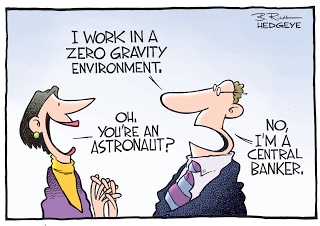Last January the Association for Evolutionary Economics (AFEE) sessions at the Allied Social Sciences Association (ASSA) meetings revolved around the theme of "Inside Institutions," meaning that within institutions there are many actors with different sets of interests, so one must look under the hood, so to speak, of the institution itself to understand its actions. My paper followed my previous discussion of the historical evolution of central banks, and a brief discussion within the Argentine Central Bank. From the abstract of my paper: Central banks are evolving institutions. In developed countries, particularly in Britain, central banks were used as instruments of the state to finance government and to promote economic development. However, once they went up the economic ladder, advanced economies kicked it to preclude developing countries from climbing it, too. It is in this context that the modern independent central bank, concerned with inflation targeting alone, which harkens back to the Victorian era, should be interpreted. This paper analyzes the recent evolution of the Argentine central bank in this broad historical perspective. Download full paper here.PS: This are the proofs and there are some mistakes. And yes, it should say seventeenth century in the first paragraph.
Topics:
Matias Vernengo considers the following as important: central banks, Heterodox Central Bankers, Institutionalism
This could be interesting, too:
Matias Vernengo writes Sharing Central Banks’ costs and profits of monetary policy in the euro area
Frances Coppola writes There’s no such thing as a safe stablecoin
Frances Coppola writes How to use People’s QE to fight climate change
Frances Coppola writes David and Goliath
Last January the Association for Evolutionary Economics (AFEE) sessions at the Allied Social Sciences Association (ASSA) meetings revolved around the theme of "Inside Institutions," meaning that within institutions there are many actors with different sets of interests, so one must look under the hood, so to speak, of the institution itself to understand its actions. My paper followed my previous discussion of the historical evolution of central banks, and a brief discussion within the Argentine Central Bank. From the abstract of my paper:
Download full paper here.Central banks are evolving institutions. In developed countries, particularly in Britain, central banks were used as instruments of the state to finance government and to promote economic development. However, once they went up the economic ladder, advanced economies kicked it to preclude developing countries from climbing it, too. It is in this context that the modern independent central bank, concerned with inflation targeting alone, which harkens back to the Victorian era, should be interpreted. This paper analyzes the recent evolution of the Argentine central bank in this broad historical perspective.
PS: This are the proofs and there are some mistakes. And yes, it should say seventeenth century in the first paragraph.

